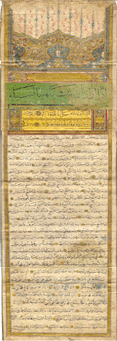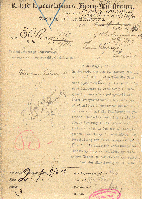The Archives of Bosnia-Herzegovine, the first modern archival institution in Bosnia-Herzegovina is established 1947. by decission of The Government of Peoples Republic of Bosnia-Herzegovina No. 1061 on December 12, 1947. Nowaday this date is known as Archives Day in Bosnia-Herzegovina.
From 1965, by provision of Archives Act, name of this institution is changed into Archives of Bosnia-Herzegovina. Today, in the independent state of Bosnia-Herzegovina, Archives works under this name.
Although archival service, as organised activity for preservation, protection and professional procession of archives in Bosnia-Herzegovina started in 1947, in Bosnia-Herzegovina there is significant tradition of preservation and keeping archives. In absence of archival institutions, a lot of archives have been kept by libraries, museums and other institutions, and also by particular persons. Many of B. H. Archives are raised from fonds of libraries and museums. Although the number of these institutions in past was small, and they did not pay attention on records today known as public archives, without these institutions many of archives would not been saved.
Bosnian governors in Middle Age had a particular cancellors and treasurers on their courts; educated persons that made charters for them. On the oldest preserved, the charter of Kulin ban from 1189. that cancellors is supscribed as dijak. Kulin's successor, Matej Ninoslav, in 13. century, had gramatig as cancellor. With dijaks and gramatigs, on Middle Age charters there are also logotet. The development of old Bosnian administration had especially grown up with coronation of King Tvrtko. In their forms, producing and physicall character, old Bosnian charters have a lot of diplomatic, paleographic and sphragistic specifics. Texts are in Bosnian; not only in Latin; there are symbolic of red colour for seals wax as exclusively governors; there are consistency in writters signature, and some more characteristics in preparing parchment, writting and seal.
Today, in Bosnia-Herzegovina just a few of charters from Middle Age are preserved. Zemaljski muzej in Sarajevo keep original of King Tvrtko's charter, issued to Hrvoje Vukčić on March 12, 1380. Archives of Bosnia-Herzegovina keep charter of King Dabiša, issued in Moštri on April 26, 1395, charter of Stjepan Tomaš Ostojić issued in February 1459, and transcript of King Dabiša's charter from 16. century. Published collections of old charters (such as Miklošić's, Ljubić's, Thallóczy's, Brković's, also a well known Farlatti's Illiricum sacrum), have significant importance for history of Bosnia-Herzegovina in Middle Age
|
A photo of King Dabiša's chart from year 1395
|
Through the longest period of Ottoman rule in Bosnia-Herzegovina (1463-1878) the records of government have been kept in offices, arranged chronollogically and by their subjects. On particular way they kept catastral defters and registers, that always have been classified in cases. The institution of defter-emin, as treasurer of official catastral books and archives, in Sarajevo as center of Bosnian Sandžak appeared in 16. century. There are also significant institutions of tezkiredžija (writter of charters), divan-katib (writter), tevkiija or jazidžibaša (chief of writters). As there were in Ottoman administration court registers have been known as sidžils, and court office as mehkeme, there were institutions named mehkeme-emin.
Defters are the most interesting archives, because of their value and lot of data they contain.
 In the middle of 19. century, reforms in Ottoman Empire had a significant influence on administrative sistem, and in a such way on records management. After Act on Bosanski vilajet, on November 7, 1864, and its becaming into force, on June 9, 1865, in the central Vilajet's government was established office for keeping records. As the institution for administrative activities, with organised office for correspondence, in article 9 of Act on Bosanski vilajet was established mektubžija. This office had a special repository, administrated by particular employee (evrak müdürü). The records have been kept in rundled cases, that have been closed on the end of each year, with the note about subjects of records. In sandžaks, as lower administrative units, there were established offices with employees for correspondence, because the administration had not been so strictly centralised as earlier.
In the middle of 19. century, reforms in Ottoman Empire had a significant influence on administrative sistem, and in a such way on records management. After Act on Bosanski vilajet, on November 7, 1864, and its becaming into force, on June 9, 1865, in the central Vilajet's government was established office for keeping records. As the institution for administrative activities, with organised office for correspondence, in article 9 of Act on Bosanski vilajet was established mektubžija. This office had a special repository, administrated by particular employee (evrak müdürü). The records have been kept in rundled cases, that have been closed on the end of each year, with the note about subjects of records. In sandžaks, as lower administrative units, there were established offices with employees for correspondence, because the administration had not been so strictly centralised as earlier.
With this reforms Bosnia-Herzegovina got a modern records management. There were protocols (records registers for correspondence between vilajets and sandžaks, for correspondence with Austrian consul and with Ministry of Finance; and also for registering orders from higher levels of administration, and for telegrams). In this protocols received and issued records were registered partially. Records were arranged per numbers, a protocols were closed on the end of each year. Taking example from actual European practice, records were registered in abstract, so there were not classic registers, than the evidence which have archival value by itself.
At the moment of establishing its rule in Bosnia-Herzegovina in 1878, Austro-Hungarian Empire was a state with developed archival service and developed systems of records management. Just in 18. century there are known instructions about detaching current and non-current records; there are lot of organised repositories in public offices, but also organised archival institutions and buildings.
In this 40 years long period in Bosnia-Herzegovina were two initiatives for establishing Zemaljski arhiv (Archives of Bosnia-Herzegovina), in 1909. and 1914.
|
First page of document about selection and disposal of records 1909 |
In 1909 initiative for establishing of Zemaljski arhiv raised from practical administrative needs, because within period of thirty years of Austrian rule there were already thirty millions of records, such there were not enough space in repositories.
This initiative has been rejected, but Instruction for disposal of worthless records had been issued. Provisions of this Instruction regulated disposal in periods of five years, keeping in agencies of Government for twenty years, and after thirty years storage in Archives; it means after fifty years. In other words, besides removing worthless records, provisions of Instruction determined the records of continue value, for storage in Archives. One of the especially importance is rejecting a proposal of unique access in disposal, because of consciousness of variety of archives. Regularly disposals would result at the end in division all records in two parts: older and newer. Also, it was determined that all older archives must be transferred to Zemaljski muzej.
Although the Archives in modern sense have not been established in Austro-Hungarian period, there have been organized activities on keeping archives. Besides, during this period, archives have been scientific processed and published. It is merit exclusively of Zemaljski muzej in Sarajevo, that has been kept the most valuable archives from Bosnian past, not only in that period, then in a period after year 1918.
Zemaljski muzej was established in 1888. In next year it started its Glasnik [Bulletin], in which were published a lot of archives, as well as a lot of papers useful for learning of archival problematics.
In period between two World Wars on territory of Bosnia-Herzegovina has not been established Archives. Nor Project of State Archives of Yugoslavia, dated between 1931. i 1934., was not realised, and such in Bosnia-Herzegovina had not been establihed an Archives. In this period, there were issued few acts in records management.



